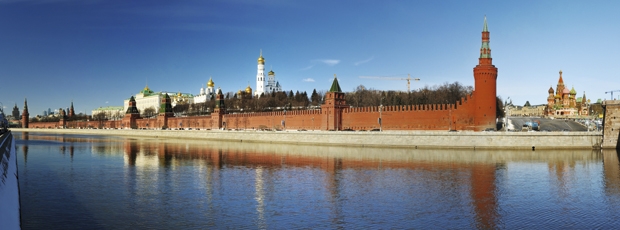A building bearing testimony to the power of eternal Russia; a timeless symbol of the Russian state; a monument to Russian sovereignty. To the modern eye, the Kremlin fortress seems as if it had always been there, as if it had never changed and never will.
All of which is utter nonsense, as Catherine Merridale’s fascinating history reveals: the story of this famous compound is not one of continuity, but of construction, destruction and reconstruction. Every reincarnation of the Russian state over the centuries — and there have been many — has been accompanied by a corresponding reincarnation of the Kremlin. Its history is thus a metaphorical history of Russia, as Merridale understands very well. ‘If states have trademarks,’ she writes, ‘Russia’s could well be this fortress, viewed across Red Square.’
Despite outward appearances of solidity, there are numerous holes in the story. It is not known for certain when anyone first built something on top of the hill overlooking the Moscow and Neglinnaya rivers. Probably the first settlers were Finns; the first Slavs arrived relatively late, at the beginning of the 800s, but for centuries they did not build so much as a stone palace in Moscow, a provincial trading post far from the glittering cities of Kievan Rus, at that time the dominant Orthodox power, and unimaginably far from Catholic Europe.
A monastery was built on the hill in the 13th century, and a wooden fortress certainly existed in the 14th century. A number of other churches followed. But although many of these rather primitive buildings were ‘retrospectively endowed with majesty’, the site actually burned several times and nothing much of the medieval structure remains. Only in the early 16th century were the Kremlin’s rulers wealthy enough to hire Italian stone-cutters, German cannon-founders and Persian smiths in sufficient abundance to produce the foundations of the brick walls and
towers that remain today, as well as the predecessors of the modern palaces and churches within the walls.
On the one hand protected from the local mob and from foreign invaders, on the other hand closed within itself, the Kremlin complex evolved into a space ideally designed to incubate highly authoritarian, centralised, secretive regimes. Yet despite the myths, the fortress was never impregnable. In the 17th century, the Kremlin was occupied by the Poles; in 1812, Napoleon strode its corridors. Even in times of peace it was never comfortable either. Merridale describes the lives of the ‘gowned, whey-faced officials at the bottom of the administrative heap’ in the 1550s, the days of Ivan the Terrible:
The rooms in which they laboured were barely furnished and poorly lit. If there were windows, they were small, and any light that entered would have had to pass through a film of mica or fish-bladders rather than glass. Meanwhile, the stoves and tallow candles that burned almost all the time would have made the atmosphere permanently sooty…only the chief clerks had the luxury of desks or chairs; the rest spent long days squatting on the floor.
Those dark, primitive interiors and the inward-looking thinking they encouraged eventually drove Peter the Great out of Moscow in the 18th century. He created
St Petersburg as a window on the West, and left the Kremlin to decay. Though it was reimagined in the 19th century as a nationalist shrine, only in the 20th century did a new set of Russian imperial leaders make the Kremlin their capital again. Lenin personally assigned apartments to his closest staff — Stalin got a large flat in the Poteshnyi Palace — and various ancient buildings were converted into canteens for leading Bolsheviks, or garages for their cars.
Like every regime that had preceded them, the Soviet communists remade the Kremlin in their own image. So thoroughly did they change the architecture that a Kremlin resident assured Merridale in 2007 that ‘there never was a monastery in the Kremlin’. In fact, Stalin dynamited two of them in 1929. The conservationist who had pleaded to save them and their precious frescoes died in the Gulag a few years later.
Stalin’s agents were naturally drawn to the Kremlin’s hidden rooms and
passageways, and probably built some of their own. Kremlin officials refused to confirm or deny the existence of an underground link between the fortress and Stalin’s old dacha. They told Merridale to ask her own country’s intelligence services about it, for they surely knew.
Boris Yeltsin’s decision to move into the Kremlin set the tone for the new, post-Soviet Russian regime. In the Putin era, the building has been re-fitted with high-tech security and communications, but the aura of the place has not changed. Towards the close of this superb book, Merridale follows a tourist group around the citadel. She listens to false stories of ancient princes and to carefully edited versions of the past, before noting that one direction was roped off: ‘There was no access to the view towards the Kremlin’s presidential building.’ As in the past, she concludes, the real life of the Kremlin is off- limits to ordinary Russians:
The cut and thrust of real politics, the compromises, corruption and deals, are hidden because everything depends on myth. Like many regimes of the past, today’s Russian government continues to shelter behind iconic Kremlin walls.






Comments